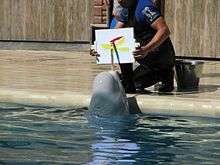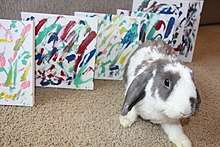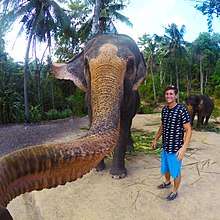Animal-made art
Animal-made art is art created by an animal. Animal-made works of art have been created by apes, elephants, cetacea, reptiles,[2] and bowerbirds,[3] among other species.
Painting primates

During the late 1950s, biologists began to study the nature of art in humans. Theories were proposed based on observations of non-human primate paintings. Hundreds of such paintings were cataloged by Desmond Morris. Morris[4] and his associate Tyler Harris interpreted these canvas paintings as indications of an intrinsic motivation toward abstract creativity, as expressed through an exploration of the visual field and color. Many of these painters progressed over time by expanding or contracting the area of paint coverage, the horizontal or vertical stroke relationships, and even the development of content.
Such paintings were exhibited in many modern art museums during an early 1960s and late 1950s. The cultural and scientific interest in these paintings diminished steadily and little note is taken today.
A more recent example is Pockets Warhol, a capuchin monkey, who has been painting since 2011.
Painting elephants
Elephants in captivity have been trained to paint as a form of zoo environmental and behavioural enrichment. An example of this is seen at Melbourne Zoo.[5] However, research published in 2014 indicated that elephants gain little enrichment from the activity of painting apart from the positive reinforcement given by zookeepers during the activity. The scientists concluded that the "benefits of this activity appear to be limited to the aesthetic appeal of these paintings to the people viewing them". The elephants draw the same painting each time and have learned to draw it line-for-line.[6] It has been alleged that cruelty is involved in some tourist destinations where elephants are trained to paint.[7]
Painting dolphins

In some dolphin shows, educated dolphins [8][9][10] and beluga whales[11] paint with brushes. The Institute for Marine Mammal Studies has taught several of its dolphins to paint.[12]
Painting rabbit

The Bini the Bunny YouTube channel contains several videos of the titular rabbit painting abstract art on small canvases, holding a brush in his mouth.[13]
Copyright issues

The copyright to an artistic work is typically held by its author. In cases where the artistic work was created by an animal, intellectual property analysts Mary M. Luria and Charles Swan have argued that neither the human who provides the equipment used to create the work, nor the human who owns the animal itself (when applicable), can hold the copyright to the resulting work by the animal. In these cases, the animal's work was not an intellectual creation of the humans, and copyrights can only be held by legal persons—which an animal is not.[14]
The question of ownership of copyright for photographs created by animals was tested in the monkey selfie case, in mid-2014. Equipment owned by nature photographer David Slater was used by a Celebes crested macaque in Tangkoko Nature Reserve in Indonesia to take a series of self-portraits. Slater claimed copyright over the image, arguing that he had set up the situation. Other individuals and organizations, however, argued that the photographs, as the work of a non-human animal (and thus not the work of a legal person), were public domain.[15] Slater stated that the upload of the images to Wikimedia Commons, a free media repository, had cost him more than £10,000 in lost income; he unsuccessfully attempted to have the media removed.[16][17] In August 2014, the United States Copyright Office clarified their rules to explicitly state that items created by a non-human cannot be copyrighted, and lists in their examples a "photograph taken by a monkey", which would appear to reference this case.[18][19]
See also
- F.D.C. Willard
- Infinite monkey theorem
Footnotes
- "The amazing elephant selfie. But is it a world first?". BBC. 22 May 2015. Retrieved 22 May 2015.
- Ramde, Dinesh (7 April 2008). "Dumbo paints! Animals make zoo artwork". USA Today. Gannett Company. Associated Press. Archived from the original on 10 August 2014. Retrieved 14 August 2014.
- Diamond, Jared (1 May 1986). "Animal art: Variation in bower decorating style among male bowerbirds Amblyornis inornatus". Proceedings of the National Academy of Sciences of the United States of America. National Academy of Sciences. 83 (9): 3042–6. doi:10.1073/pnas.83.9.3042. PMC 323443. PMID 16593691.
- Morris, Desmond (1962). The biology of art: A study of the picture-making behaviour of the great apes and its relationship to human art. Taylor & Francis.
- "Animal artistry". Zoos Victoria. Archived from the original on 12 August 2014. Retrieved 14 August 2014.
- English, M; Kaplan, G; Rogers, LJ (2014). "Is painting by elephants in zoos as enriching as we are led to believe?". PeerJ. 2: e471. doi:10.7717/peerj.471. PMC 4103097. PMID 25071994.
- "Elephant Artists? Here's Why Making an Elephant Paint is Cruel, Not Cute". One Green Planet. Retrieved 2017-01-25.
- Padgett, Sonya (February 3, 2013). "Mirage dolphins take artistic turn, making paintings for guests". Las Vegas Review-Journal. Retrieved August 18, 2016.
- Phillips, Steve (2014). "Dolphins at IMMS learn to paint for new interactive program". WLOX-ABC. Retrieved August 18, 2016.
- Sanchez, Frank (2008). Dolphin Painting Project. Retrieved August 18, 2016.
- The Telegraph:Beluga whales learn how to paint
- McCoy, Amanda (February 24, 2014). Painting Dolphin. SunHerals Multimedia. Retrieved August 18, 2016.
- "Talented Little Bunny Creates Beautiful Works Of Art, All On His Own!". Jumble Joy. Retrieved 11 February 2017.
- "Monkey Selfie Lands Photographer in Legal Quagmire". The Lightbox. Time. Retrieved 11 August 2014.
- "Can monkey who took grinning self-portrait claim copyright?". Metro. Retrieved 24 June 2014.
- "Photographer 'lost £10,000' in Wikipedia monkey 'selfie' row". BBC News. August 7, 2013. Retrieved August 7, 2014.
- "Wikipedia reveals Google 'forgotten' search links". BBC News. August 6, 2014. Retrieved August 8, 2014.
- Axelrad, Jacob (22 August 2014). "US government: Monkey selfies ineligible for copyright". The Christian Science Monitor. Retrieved 23 August 2014.
- "Compendium of U.S. Copyright Office Practices, Third Edition (public draft)" (PDF). United States Copyright Office. 19 August 2014. p. 54. Archived from the original (PDF) on 25 September 2014. Retrieved 24 September 2014.
External links
| Wikimedia Commons has media related to Animal art. |
- Conn Ó Muíneacháin, "‘Monkey Selfie’ Photographer David Slater on his Fight with Wikipedia (audio)", www.technology.ie/ August 14, 2014. —Audio file.
